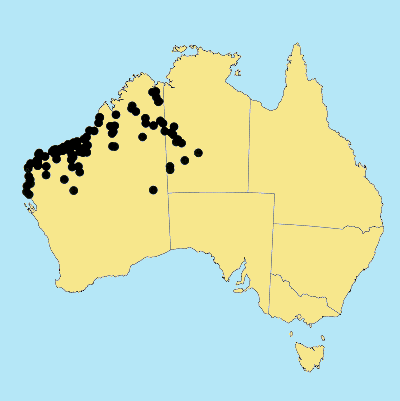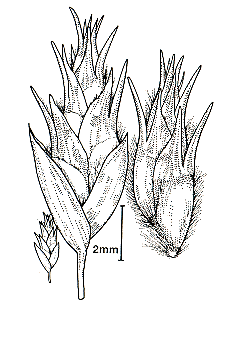Triodia epactia S.W.L. Jacobs. Nuytsia
8: 220 (1992).
Classification. (GPWG 2001) : Subfamily
Chloridoideae. Triodeae.
Type of Basionym or
Protologue Information: Western Australia: Northern Province; southern end
of 80 mile beach, 3.viii.1970., R.C. Carolin 7581 (HT: NSW; IT: SYD).
Key references
(books and floras): [2002] D.Sharp & B.K.Simon, AusGrass, Grasses of
Australia.
Illustrations:
[2005] K.Mallet (ed.), Flora of Australia 44B: Poaceae 3 (fig.
35Q-S).
Habit.
Perennial. Stolons absent or present. Culms 60–200 cm tall. Lateral branches
fastigiate. Leaf-sheaths smooth, glabrous on surface. Ligule a fringe of hairs,
0.5–1.3 mm long. Leaf-blades straight or curved or curled or flexuous, flat or
conduplicate, 15–35 cm long, 0.7–2 mm wide. Leaf-blade surface smooth.
Inflorescence.
Inflorescence compound, a panicle. Panicle linear or lanceolate or oblong,
dense, 10–51 cm long, 1.5–3.5 cm wide.
Spikelets.
Spikelets pedicelled. Fertile spikelets many flowered, with at least 2 fertile
florets (5–9), comprising 5–9 fertile floret(s), with diminished florets at the
apex, lanceolate, laterally compressed or terete, (7–)9–12(–16) mm long.
Glumes.
Glumes similar, thinner than fertile lemma. Lower glume lanceolate or oblong,
scarious or cartilaginous or indurate, keeled, 1-keeled, 3–5(–7) -nerved. Lower
glume surface glabrous. Lower glume apex muticous or mucronate. Upper glume
lanceolate or oblong, (3–)4.5–11 mm long, scarious or cartilaginous or indurate,
keeled, 1-keeled, 3–5(–7) -nerved. Upper glume surface asperulous, glabrous.
Upper glume apex entire, muticous or mucronate.
Florets.
Fertile lemma 4–10 mm long, without keel or keeled, 9–15 -nerved. Lemma surface
indumented. Lemma apex lobed, muticous. Lodicules present. Anthers 3.
Continental
Distribution: Australasia.
Australian
Distribution: Western Australia, Northern Territory.
Western Australia:
Gardner, Fitzgerald, Hall, Dampier. Mueller, Canning, Keartland, Giles,
Fortescue, Ashburton, Carnarvon. Northern Territory: Victoria River,
Central Australia North, Central Australia South.
Notes.
Distinguished by its narrow, dense panicle; closely flowered spikelet;
bitextured, broadly winged lemmas with an abrupt junction between the thickened
yellow body and thin wings; prominent lemma lobes terminated with a bristle,
which are subequal to the lemma body in length; bitextured, beaked paleas with
winged keels.
Mainland
and coastal islands of W.A. N of 26°S and in nearby areas of the N.T. Chiefly
in deep, red or white or pink-brown, sandy soils on sandplains, sandhills,
swales, pindan and coastal calcareous dunes, in association with granite,
basalt, quartzite, sandstone, shales, limestone and laterite; also on river
frontages, clay pans, rocky hills, gravelly rises, black gravelly sandy loam,
and red earths; flowers all seasons, but not recorded in Dec.




